GREEN- The ways Charlottesville is getting greener
Even Kermit the Frog is changing his tune.
After years of singing to the contrary, there was Kermit during the Super Bowl telecast two years ago, riding through the woods on a bike, kayaking white-water rapids, and scaling the face of a mountain, only to discover a hybrid SUV in the middle of a clearing.
That prompted the not unexpected, "Hmm! I guess it is easy bein' green!"
Well, two years and An Inconvenient Truth later, Charlottesville seems to be catching the green wave, too. From the cars we drive to the food we eat, from the center of Downtown to the outskirts of Nelson County, efforts big and small are under way to make sure that the land of the Blue Ridge stays green. Here's a sampling of the myriad changes happening all over Central Virginia.
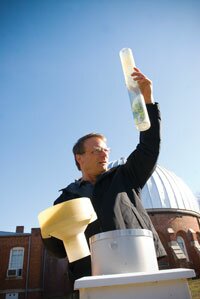
After 30 years of sitting on the fence, the UVA Climatology office is finally a player in combatting global warming, thanks to Jerry Stenger.
FILE PHOTO BY JEN FARIELLO
Jerry Stenger replaces Patrick Michaels at UVA, admits global warming is real
For nearly 30 years, the University of Virginia Office of Climatology was the dominion of State Climatologist Patrick Michaels, a veteran scientist in the field, author of such climatological page-turners as The Satanic Gases and Meltdown, and vehemently vocal critic of the notion of global warming.
"The earth– traditionally, except for the Ice Age– has been warmer than it is now," he told the Hook in 2004, "and the plants that we depend on for food evolved on a planet that was several degrees warmer than it is today."
Finally, last year, amid the growing consensus that global warming is a real phenomenon, Michaels resigned his post and went into private consulting, leaving his longtime second-in-command, Jerry Stenger, to man the controls of the UVA Climatology Office.
"Neither I nor many other climatologists have agreed with all of his conclusions," says Stenger of Michaels, "but the basic science that went into them was generally sound, and nobody who knows him questions the sincerity of his beliefs. It's unlikely that any force on earth could have compelled him to do anything but speak his own mind."
And while he worked side-by-side with one of the most vocal dissenters in the weather community, Stenger has some ideas of his own about global warming.
"Sure, it exists," he says. "There's little doubt that the available data shows that global average temperatures have increased rather sharply over the last 30 years. The fact that this has occurred over the period of a great increase in the amount of 'greenhouse gases' leads to the reasonable conclusion that at least part of it is driven by human activity."
Now that he's at the helm, perhaps Stenger will be able to get the word out to his neighbors in the Charlottesville-Albemarle area, who drive an above-average number of cars (see p. XX).

Reservoirs like the Sugar Hollow Reservoir were in danger of getting to drought levels in the fall
PHOTO BY HAWES SPENCER
Water conservation efforts actually worked!
Last fall, things looked grim for Charlottesville's water supply. September 2007 was the fourth-driest September on record in Charlottesville, when only 0.69 inches of rain fell, well off the average of 4.2 inches. Reservoir levels were dropping fast, which proved worrisome not only for the immediate future but for the coming spring and summer months.
Remember the drought of the summer of 2002? That arid period of brown lawns, dirty cars, and fine dinners served on paper plates? That was due to lower-than-average rainfall in the preceding fall and winter, when plants weren't sucking the wet stuff out of the ground and a hot sun wasn't evaporating the moisture.
The Rivanna Water and Sewer Authority declared a drought warning, and its director, Tom Frederick, warned, "If we have low groundwater tables going into next summer, it's dangerous."
So the city and county launched a massive PR campaign, urging citizens to install low-flow toilets, fix leaks, recycle shower water for washing dishes, and other water conservation efforts, because, as they cautioned in a series of radio ads "water is not a renewable resource."
"Sure, the hydrologic cycle is there," said Albemarle service authority director Gary Fern at the time, "but within our service area, our reservoirs are limited in size, and once we use it up, it's gone."
Now that temperatures are getting warmer, flowers are blooming, and every plant under the sun is competing with us for every drop of rain, how do the spring and summer look?
"We were hoping for a five percent reduction in water use," says RWSA spokesperson Andrea Terry. "We got a 10 percent reduction."
And the water levels?
"All of our reservoirs are full," she says.
And so we can bathe easy for another spring and summer. But if it hadn't been for citizens jumping into action, the situation might have been much more dire.
"We were really getting into a difficult phase," says Terry. "It needed to happen."

Sorry, Bonnie Raitt. No Styrofoam cups or non-local produce for you.
FILE PHOTO BY WILL WALKER
Charlottesville Pavilion puts the spotlight on green
Whether it's hosting a honky-tonk hoedown with George Jones, a jammin' good time with Ziggy Marley, or an otherworldly spectacle from the Flaming Lips, when 3,500 people gather at the Charlottesville Pavilion for a concert, one thing is always certain:
"At every show, we generate a ton of trash," says Pavilion general manager Kirby Hutto.
But rest easy, because evidently the lawn isn't the only thing that's green at the Pavilion.
"Basically, if we have control over it, we try to make it more environmentally friendly," Hutto says.
As with most things in the concert promotion business, going green at the Pavilion was apparently only a matter of numbers.
"The biggest thing we've done is switch from #1 plastic cups to #6 plastic cups for our beer," Hutto says. "We had #1 plastic cups, but there's no market for recycling those. When we wanted to switch to the #6, we had a hard time finding a source, and they cost 60 percent more, but you can recycle them. It costs us money, but it's the right thing to do."
Not even stars can indulge in wasteful ways.
"We don't use any Styrofoam in our backstage catering; we use as much local produce as we possibly can; we serve local Starr Hill beer," Hutto says. "Most of the artists are very earth-conscious anyway, but we try to make sure."
And while the Pavilion has a recycling bin to go with every garbage can, Hutto doesn't trust that everyone will be diligent about where to put trash. So he makes sure the cleanup crew makes the extra effort and digs deep.
"After every show," Hutto says, "we open every single garbage bag and separate it into what's recyclable and what's not."
And you thought you had a hard time sorting your garbage.
"The crew stays about two to two-and-a-half hours after the show," he says. "It may take a while, but our patrons expect us to make an effort, and in the long term it'll work out for us."
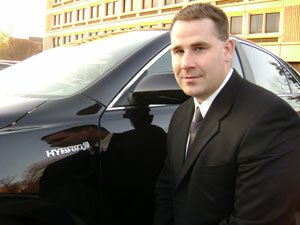
Dwight Ledford drives clients in swank leather splendor while getting 34 miles per gallon.
PHOTO BY LINDSAY BARNES
Hot shots roll in eco-friendly style
Last year, after a series of odd-jobs including being a United States Marine, Dwight Ledford was at home watching the news when he knew all at once what his next career move had to be.
"I saw that in New York, Mayor [Michael] Bloomberg was mandating that all the taxis become hybrid vehicles," he says. "That put a light bulb in my head."
Two weeks later, Ledford was the proud owner of a Ford Escape Hybrid, the first vehicle in the fleet he calls Go Green Transportation.
"I started by doing airport service with the other taxis," he says, "but then word of mouth got around and people started making reservations with me for long trips to D.C. and Richmond."
One person in particular who caught wind of the green car wave was Bill McDonough, one of the world's most renowned "green" architects who's worked on projects with the likes of Bill Gates and Brad Pitt.
"I'm doing this with the idea of being 'eco-luxury,'" says Ledford. "So they have a lot of big clients coming in, and they do a lot of flying out of Dulles and Richmond, and they said it was perfect for them. I'm driving them at least once a week now."
With his fleet now including another Escape and a plush, leather-seat Toyota Camry, Ledford is hoping to grow his business by tapping into the rich market of wealthy, earth-conscious consumers in Charlottesville.
"There's going to be a need for a car service no matter what," Ledford says. "I'm just trying to do it in a way that makes our resources last a little longer."
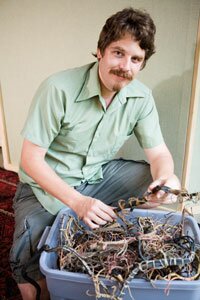
Got old wires you don't need anymore? Monkeyclaus' Peter Agelasto can't wait to get his hands on them.
PHOTO BY BILLY HUNT, COURTESY OF MONKEYCLAUS
Old electronics spark new ideas
Having become one of the largest electronics retailers in the country over the last 34 years, Crutchfield has come to know a thing or two about what happens to old parts when the device of which they're part stops working.
"Old TVs, old computer monitors– they usually just end up in the landfill," says Jim Richardson, a spokesman for the company. "Every company, especially one like us, generates plenty of e-waste."
So Crutchfield began to think about what people might do with their old gadgetry when they came into the store to buy new.
"We looked around to see where people could recycle their electronics year-round, and it turned out there wasn't such a place," he says. "So we decided to do it ourselves."
So in 2006, with the blessing of the Rivanna Solid Waste Authority (which usually handles all things related to recycling), Crutchfield began offering customers a place to bring their once-working or out-moded gear to be deposited into a trailer. There, a company will take apart the deficient device to salvage the working parts, with the guarantee that not one button or knob will find its way to the landfill.
Richardson says the program has become a huge success.
"The Solid Waste Authority told us to expect around 20 tons per year," says Richardson. "Since we started this in August 2006, we've gotten 295 tons."
If Crutchfield employees have caught any audiophiles rummaging through the trailer, the Hook may have found the culprits.
"You can find all kinds of old wire for free," says Peter Agelasto, founder of a Nelson County artist community and recording studio, Monkeyclaus, "and we have become wire addicts."
Why the craving for cable? According to Agelasto, when they were getting ready to re-wire their studio, they found that modern-day wire just doesn't provide enough aural satisfaction.
"A lot of musicians are concerned about analog versus digital recording," he explains, "but the bigger difference is in the wiring. Most of the new stuff is made from recycled metal, which is good, but it just doesn't sound as good. For different wires, be they from old telephone patches, old lamps, or old appliances, or other stuff that would otherwise be in the landfill, different pure metals allow you to play with different kinds of sound."
The producer and engineer says he stumbled onto the technique by talking to elder audiophiles and then applying the tried-and-true test for audio equipment: a Steely Dan album.
"We put on The Royal Scam," says Agelasto, "and you could totally hear the difference. Some wires brought out the lower tones, others put the emphasis on the middle-to-high range tones, others made it sound downright sinister. It's amazing how you can use different wires and hear things you never heard in a song before."
Agelasto says the scavenging has already paid dividends, especially with so much of Charlottesville's music scene planted firmly in American roots music.
"If you want a '30s sound, use '30s wire," he says. "Musicians are starting realize that, and they're coming to us so they can get the exact sound they want."
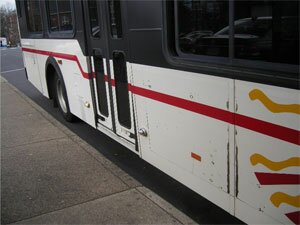
Hey! You stopped for 992,476 people last year! Wait up!
FILE PHOTO BY LISA PROVENCE
Public transit usage is up!
More frequent service, better on-time performance, and free rides for Wahoos. The head of Charlottesville Transit Service says these are three factors that led CTS to a ridership spike of 11.5 percent from this time a year ago and to log its one-millionth passenger of the fiscal year (in February) with five months to go.
"I feel encouraged," says CTS transit manager Bill Watterson. "We're demonstrating that we can make ourselves work better."
At our request, Watterson provided the Hook with route-by-route ridership figures that show that 69 percent of the rides occur on just two of CTS's 18 routes: the Free Trolley, which connects UVA and downtown, and the #7 bus, which links downtown to Fashion Square Mall, passing such hotspots as the Corner, Barracks Road, and K-Mart/Seminole Square.
"Those two routes," explains Watterson (no relation to the famous Calvin & Hobbes cartoonist), "provide service every 15 minutes, which is bigger than everywhere else we do."
The system has come under fire for allegedly sparse coverage and long intervals between buses, but Watterson notes expanded Sunday service, and he points out that Albemarle County funded extra buses for Route #5 this year, bringing that schedule to 30-minute intervals— up from last year's hour-long gap between buses connecting Barracks Road Shopping Center and Wal-Mart.
The success of CTS's new $6.5 million transit center has some City and County leaders expressing interest in creating a $100 million+ regional transit system to serve a larger geographic area. In the meantime, here's the list of routes, their total numbers of riders, and their destinations:
Free Trolley 326,264 UVA
Route 1A 11,049 Woolen Mills
Route 1B 10,507 PVCC
Route 2A 10,788 Old Martha Jeff
Route 2B 10,448 Fifth St. Extd.
Route 3A 25,629 Belmont
Route 3B 15,107 Greenleaf
Route 4A 29,679 Cherry Ave.
Route 4B 28,435 Fry's Spring
Route 5 71,959 Wal-Mart to Barracks Road
Route 6A 23,483 Ridge Street
Route 6B 16,554 K-Mart
Route 7 343,910 Fashion Square
Route 10 34,366 New Martha Jefferson
Route 21 4,665 Belmont (night)
Route 22 7,361 Prospect (night)
Route 23 1,286 PVCC (night)
Route 24 3,908 Pantops (night)
Other 17,075
TOTAL 992,473
–All routes originate Downtown unless otherwise noted.
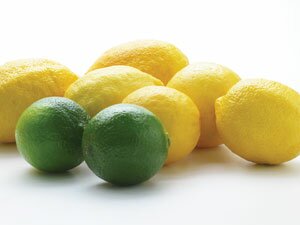
Lemons? Limes? Vinegar? In the cleaning aisle?
STOCK PHOTO
Clean team keen on bein' green
When Betsy Dance decided in 2004 to relocate from Michigan to the town of her alma mater, UVA, she thought back to what she had seen on the street in the similarly eco-minded college town of Ann Arbor.
"I saw cars driving around that were like Molly Maids, except they were green cleaners," she says. "I looked around Charlottesville to see if something like that existed here, and it didn't."
So with that, she founded Eco-Clean, a maid service using only environmentally friendly products.
"That means no ammonia, no chlorine, no preservatives, or artificial fragrance, just all natural stuff," Dance explains, "and it works!"
When she started out, Dance insisted on mixing her own ingredients.
"You'd be surprised what a little vinegar, or Borax, or lemon can do," she says. "But now we buy from a distributor. Clients seem more comfortable with stuff in pre-manufactured bottles. I don't mind, because it means buying from the companies that support the same ideas."
She's also now part of a bigger company called One Clean World, the brainchild of construction magnate Ted Horn of Martin & Horn.
"Business is great. We clean the Charlottesville Transit Center, the Charlottesville Community Design Center, and a lot of other homes and businesses," says Dance. "There seems to be a deeper understanding than ever of how the environment affects people's lives, and they're making an easy choice. Easier than buying a Prius, anyway."
If you don't feel like shelling out the big bucks to have someone else clean your house, Dance offers this one at-home remedy nugget, particularly to the ladies:
"You know those pumice stones women use to smooth their feet? They take rings on toilets and baths right off," she says. "All it requires is a little elbow grease."
#